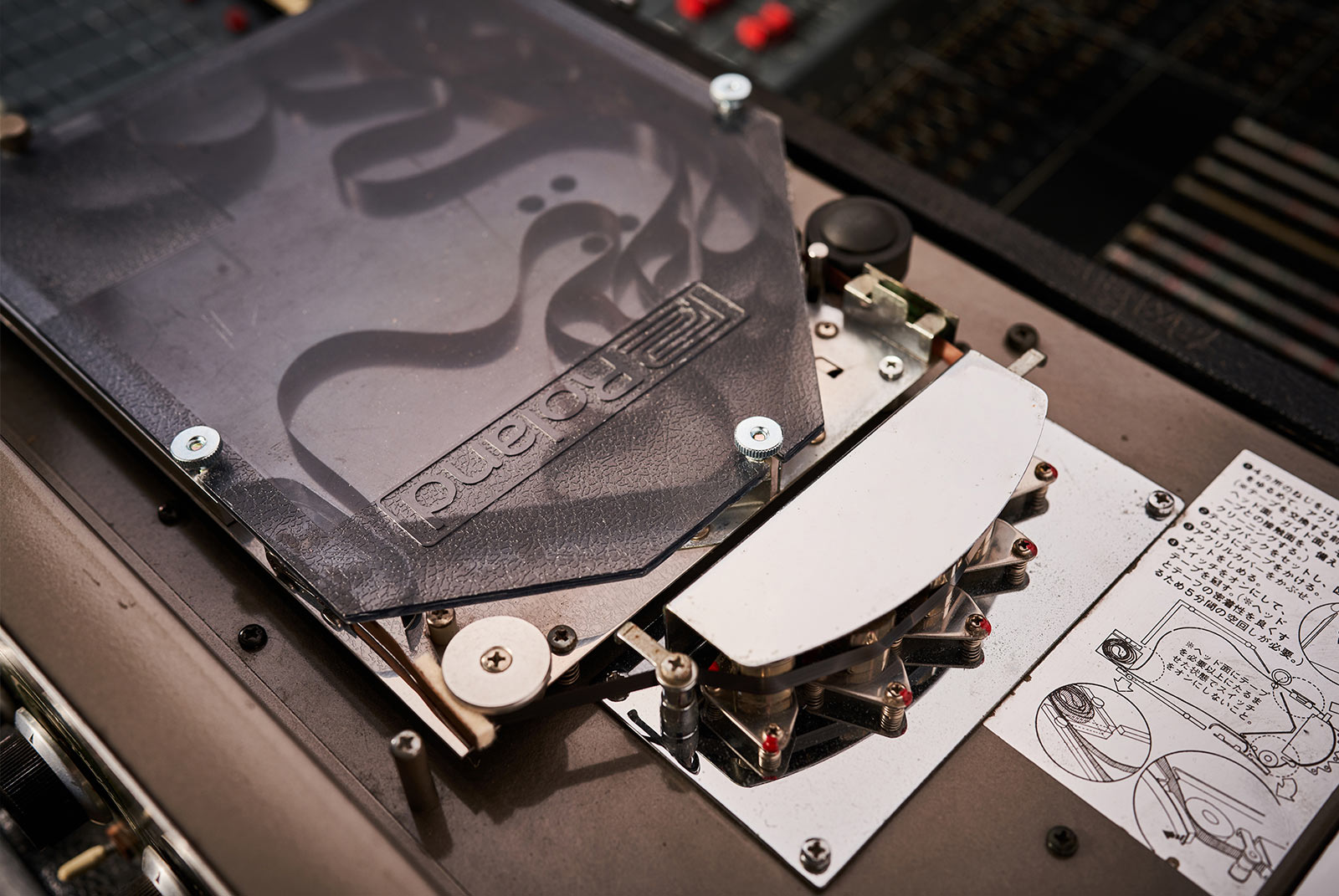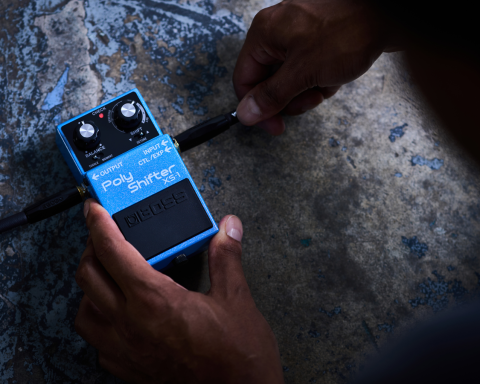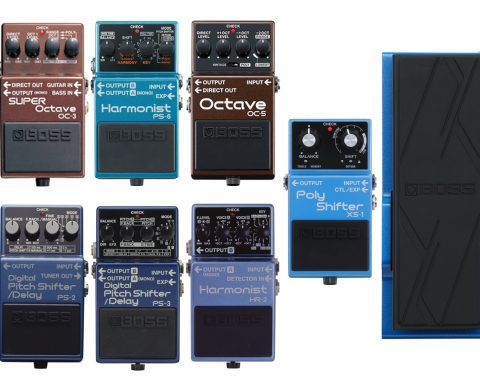To appreciate the legendary status of the Space Echo, we must examine what makes a tape echo unit like the RE-201 sound the way that it does. Tape-based echo units rely on a loop of tape that passes a record head followed by one or more replay heads. The tape then passes an erase head before it reaches the record head again so the same piece of tape passes over the heads many times during its life. By feeding some of the output from the replay heads back to the input, they create repeating echoes. Like the units themselves, these echoes seem to go on forever.
Perfect Imperfections
Most musicians regard the RE-201 as the best-engineered tape-based echo device put into mass production. Its circuitry offered better reliability and lower noise floors than earlier valve-based machines. In addition to its solid construction, the RE-201 also uses a proper erase head. Some earlier devices simply ran the tape over a permanent magnet. This didn’t erase tape cleanly.

"To grasp why tape-loop echo units sound so musical, it helps to look at the analog tape recorders that inspired them."
The Nuances of Analog Tape
To grasp why tape-loop echo units sound so musical, it helps to look at the analog tape recorders that inspired them. Even today, people love the sound of analog tape. Still, a technical analysis confirms that it has more imperfections than modern digital systems. The magnetic properties of tape cause it to compress and distort the sound at higher recording levels. In addition, repeated use of the same piece of tape results in a loss of high end performance.
There are also small pitch modulation effects caused by imperfect transport mechanics, which we call wow and flutter. Wow is a low-frequency modulation related to factors such as a misshapen rubber roller. Flutter is a faster and less regular type of modulation due to other mechanical imperfections. As a rule, wow and flutter get more noticeable as the machine ages. All these apparent flaws contribute to the musical sound of tape. It’s often described as rich or warm while a clean digital signal might sound sterile by comparison.
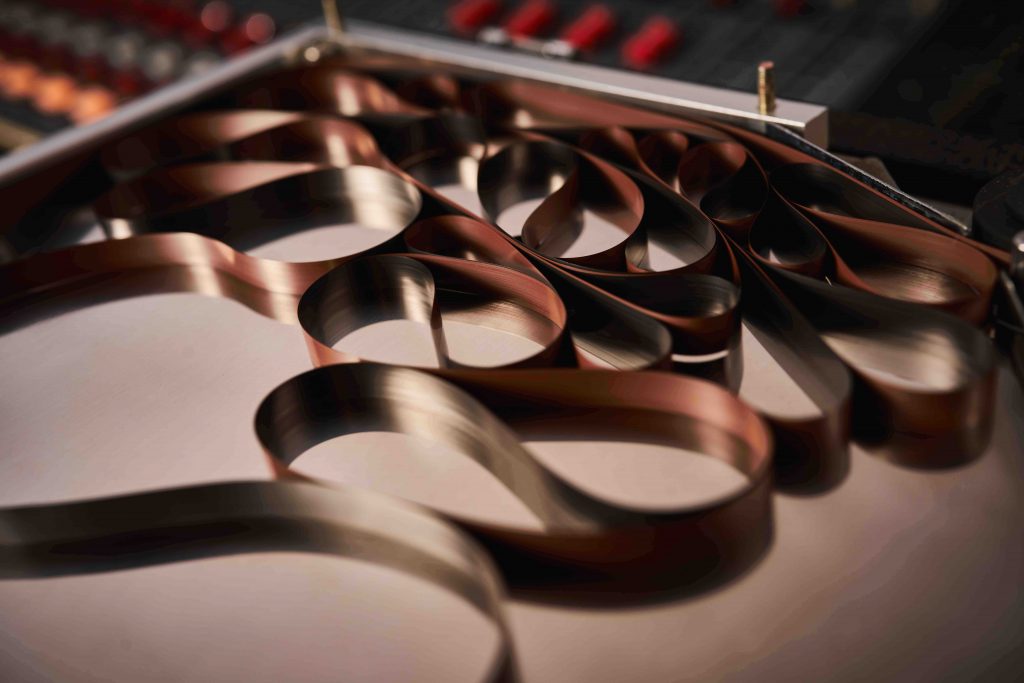
Softly Fading Repeats
Tape machine mechanics and circuitry combine to create a tape loop echo device such as the RE-201. When they do, desirable characteristics of analog tape color the sound in a way that musicians interpret as sounding warm and musical. Users create repeating delays by feeding some of the output from one or more of the replay heads back to the input. Each time the signal is re-recorded, it loses a little high end, gets more distorted, and accumulates more analog tape degradation. This has the effect of making the repeats sound as though they are melting into the distance as they die off.
"With the RE-201, desirable characteristics of analog tape color the sound in a way that musicians interpret as sounding warm and musical."
Wow and Flutter
Analog tape recorders went through decades of development to improve their audio quality. This included refining mechanics and electronics. Engineers explored new tape formations and noise reduction systems such as Dolby and dox, designed to reduce tape hiss. During this development, they attempted to minimize pitch modulation due to issues relating to the moving parts. They coined the term “wow and flutter” for these artifacts. Small amounts of wow manifest themselves as an extremely shallow, slow vibrato. Flutter occurs at higher frequencies and can have a more random character.
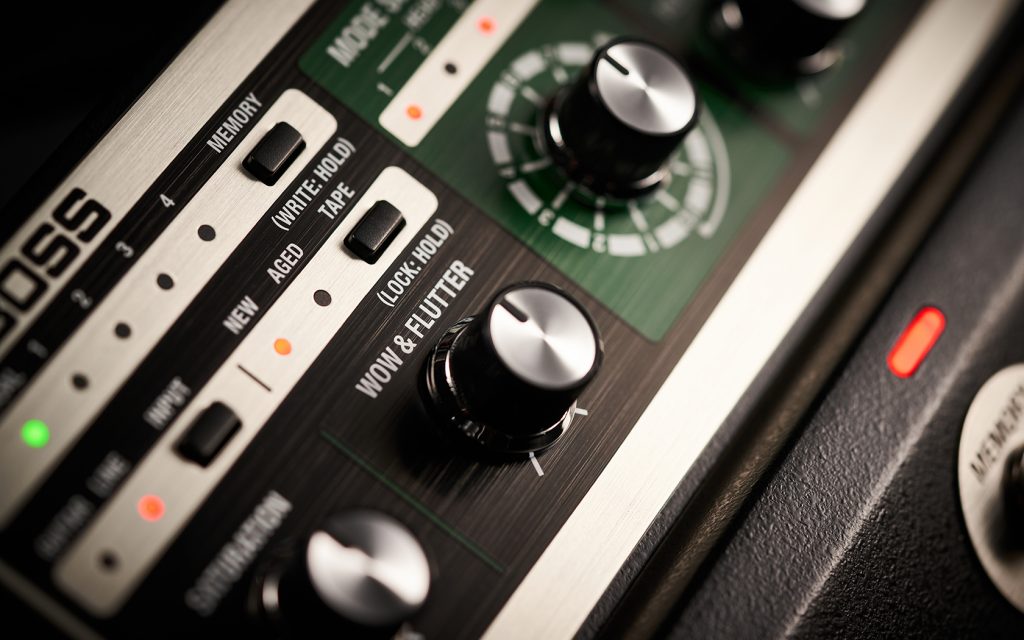
Tape Saturation
It’s well-known that magnetic tape becomes progressively more non-linear at higher recording levels. This is due to magnetic saturation. The process gives the audio a slightly compressed sound with added harmonics caused by the squashing of the waveform peaks. This occurs because the coating of magnetic tape can only hold a specific amount of charge before it becomes fully saturated. The effect of this saturation becomes more complex because users tend to apply EQ to the signal before recording. Then, they apply the inverse EQ on playback to minimize tape noise.
In controlled amounts, tape saturation adds an attractive warmth to the sound. This is one reason many people prefer the sound of analog tape to that of a digital recording. Digital audio systems don’t suffer from wow and flutter like analog tape machines. There can be measurable clock jitter that degrades the sound quality to some degree, but in modern systems it’s negligible.
"In controlled amounts, tape saturation adds an attractive warmth to the sound. This is one reason many people prefer the sound of analog tape."
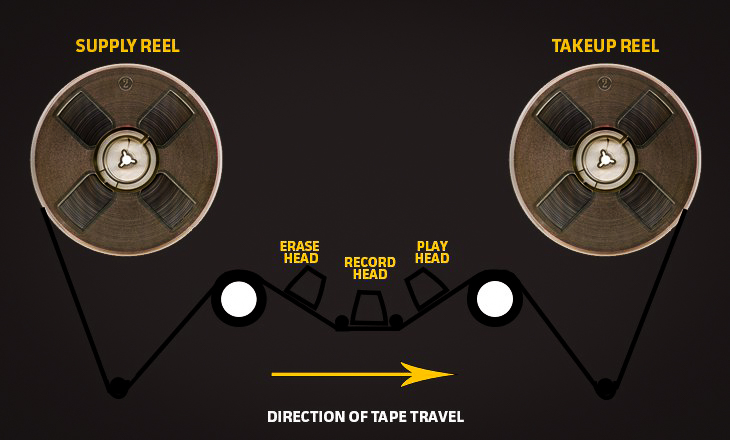
The Tape Transport
The wow and flutter in a well-designed studio tape machine may be low enough to be quite inaudible. Still, many well-loved tape echo units suffered from noticeable amounts of pitch modulation. Sometimes this was down to sloppy engineering or wear and tear. Another cause was more specific. Unlike a tape recorder, the rubber pinch roller that held the tape in contact with the capstan often remained in contact when the machine was not in use.
After a while, various dents and depressions appeared on the roller’s rubber surface. This translated into an uneven tape speed with a modulation rate matching the time it took the roller to rotate through 360 degrees. Wear in the drive shaft’s bearings can also introduce wow. In addition, the friction of the tape passing over the tape heads, especially once they get dirty, can have an effect.
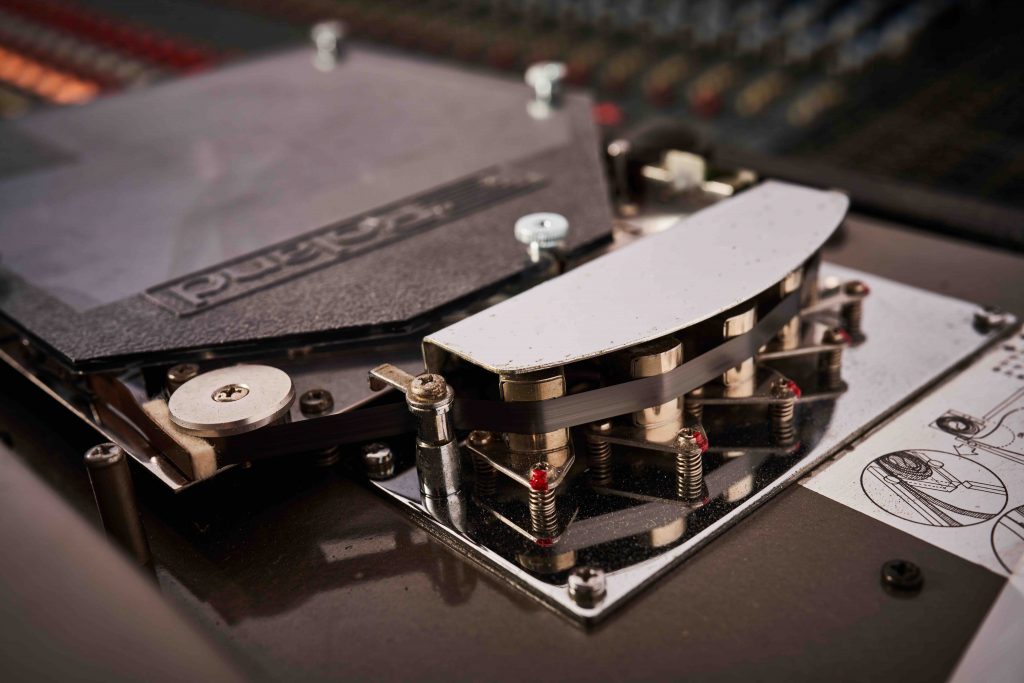
Distinctive Modulation
The original RE-201 was extremely well-engineered, producing only a modest amount of wow and flutter. Still, there was enough pitch modulation present to add character to the sound. This was also influenced by the distortions and frequency response changes imposed by the preamp circuit.
As tapes age, some of their oxide coating wears away, sometimes a little unevenly. This can also add some inconsistencies to the sound. Because the same piece of tape passes the heads many times in a tape loop echo machine, there is wear to the tape. Creases in the tape also add a distinctive type of modulation.

"The original RE-201 was extremely well-engineered, producing only modest wow and flutter. Still, there was enough modulation to add character to the sound."
The Sum of the Parts
No single aspect of a tape echo unit’s signal path is responsible for its unique sound. First of all, there is the signal coloration which electronics impose. Then there are the mechanical imperfections in the tape transport and imperfections in the tape itself.
Finally, we must consider the physics of recording and playing back from a magnetic media, and the user’s interaction with the controls. All this adds up to a very complex process that is very difficult to emulate. By applying advanced techniques, BOSS engineers replicated the RE-201 in the RE-202 and RE-2 pedals. They also provided a wider range of adjustment and stereo operation.
Echo Machine Glossary
Delay Time
A tape echo machine works by recording the input signal onto tape via a tape head. It then passes the tape past one or more playback heads to generate the delayed sound. In a tape loop echo, there must also be an erase head to clear the tape before it reaches the record head again. The delay time depends on the physical spacing of the heads and the speed of the tape.
Adjusting the motor speed adjusts the delay time. Producers used the resulting pitch change effects from adjustment as special effects. The RE-201 employed three evenly-spaced reply heads. Users could set up rhythmic repeats by using the heads in different combinations. Rather than tapes on reels, most tape echo units employ a loop of tape that continually moves past the heads. This saves the tape from ever running out, but does increase wear.
Digitally-Modeled Delay
Tape delays were expensive to build and lost out to the convenience of cheaper digital alternatives. Some purists still use original RE-201 machines. Now, modeling enables designers to build digital delays with the lovely imperfections of analog.
The BOSS RE-20 Space Echo, which dates back to 2007, was a great step forward. It offered a taste of the Space Echo experience in a compact pedal format. More digital processing and sophisticated algorithms inspired BOSS to create the RE-2 and RE-202 pedals. The engineers used several lovingly-maintained RE-201 machines as benchmarks. Any differences between the digital versions and the original are negligible.
Dry Sound
The original sound before any effects get added.
Echo Volume
Sometimes known as Swell, Echo Volume, Balance, or Wet/Dry mix, this control adjusts the balance of the repeated sounds with the original dry sound. Set fully clockwise, the input signal is usually turned to zero, leaving only the delayed signal audible.
EQ
EQ is often just a fancy way to say tone controls. The original RE-201 included Bass and Treble EQ controls that affected only the repeats. These allowed the user to make the repeats sound either warm and indistinct or brighter than normal. This facility was useful in shaping the delays so that they sat comfortably behind the dry sound.
The RE-202 has the same EQ setup, while the RE-2 uses a single tilt style tone knob. It boosts the bass while also reducing treble at one extreme and boosts the treble while reducing bass at the other. In the center position, it has no effect.
Expression Pedal
An expression pedal is physically similar to a volume pedal. However, it operates with compatible devices to control one or more parameters. Examples include an echo unit’s delay time or feedback amount. Users set up controllable parameters within the target device.
Filtered Repeats
Early digital delays delayed the signal before feeding it back to the input to create repeating delays. This generates repeats that are very close replicas of the input signal. It soon became clear that tape echo units, despite technical shortcomings, sounded more musical.
This had to do with the frequency response of tape, limitations of the recording process, and the side-effects of any noise reduction. They caused each successive repeat generated by a tape-loop echo device to lose a little clarity and to take on a more distant character. This replicates the way echoes die away in a natural space such as a canyon. The Roland Space Echo also includes EQ to allow users to control the character of the repeats over a wide range.
Preamp
The RE-201 included a preamp section to adjust the level of the audio input and boost it to the level necessary to feed the recording electronics. Subtle distortions combined with a frequency response that wasn’t entirely flat. This gave the preamp a characteristic sound. It became obvious if the level control was high enough to introduce audible distortion. The RE-202 replicates this behavior, but users can bypass it for the dry sound if desired.
Pitch Modulation
Digital delays, unless designed to do otherwise, produce delays with no natural pitch variation. The moving parts of a tape echo machine, motors, rollers, capstans, and tape guides add small speed fluctuations to the transport. This manifests itself as a slight wavering in pitch that we call wow and flutter.
When this mechanically-induced mild vibrato gets mixed with the dry signal, the effect is similar to a subtle chorus. This enhances the complexity of the overall sound. For the BOSS RE-202 and RE-2 pedals, the engineers modeled the wow and flutter on well-maintained original Roland RE-201 tape echo units. One neat refinement is that the user can adjust how much of it the effect is present.
Slapback
Slapback delay is an effect created using a single delay closely following the original sound, usually within 100ms or less. Rockabilly music uses the effect extensively. Variations appear on early Elvis Presley records. Producers often use slapback on both vocals and electric guitar.
Spring Reverb
Reverb is a very different effect from delay. It relies on reflected sound that quickly builds up into a dense, chaotic decay tail. We’ve all experienced the effect in large buildings with hard walls, such as cathedrals.
One of the earliest methods of recreating this effect in a compact form was the spring reverb. It relies on one or more weak coil springs held under a small amount of tension with a send transducer at one end and a receive transducer at the other. The send transducer feeds audio to the spring. This causes it to vibrate, sending the sound vibrations along the length of the spring.
When these reach the receiver end, some of the energy gets reflected back and forth. This means a short sound, such as a hand clap may take a second or two to die away. The signal from the receiver gets amplified and added to the dry sound to simulate natural reverb. As one might expect, springs have a slightly metallic character. However, we have become very familiar with the sound as spring reverb came with many early guitar amplifiers. The RE-201 Space Echo included a spring reverb unit in addition to the tape delays.
Repeat Echoes
To create repeat echoes, take some of the signal from one or more of the replay heads and feed it back to the input. This usually employs a control called Feedback, Sustain, or in the case of the RE-201, Intensity. The level of the signal returned to the input determines the number of audible echo repeats before the repeats fade to nothing. But if the control is fully up, the repeats recirculate indefinitely and build up into a wall of noise. We call this self-oscillation. Setting up sounds on the verge of self-oscillation, usually by adjusting the amount of feedback, is a classic dub technique.
Tap Tempo
Tape delay units forced users to adjust delay times manually, usually via a rotary control. Digital delays such as the RE-202 allow the user to tap in the song tempo by keeping time on a footswitch. The time between the last two switch presses determines the repeat rate of the delays. This enables them to match the correct tempo for a particular song.
Tape Head
Tape machines use specially designed heads for recording, playback, and erasing the tape. Engineers base these on small coils and magnetic materials arranged to produce a narrow magnetic window. The record head imprints a magnetic charge onto the tape as it passes. A replay head senses the magnetic field on the tape and converts it back to an electrical current. An erase head carries a very high-frequency signal, far above the range of human hearing. This clears the tape of any previously recorded audio signals.
Tape Loop
A single length of tape with spliced-together ends forms a continuous loop. On some machines, the loops were quite short, simply passing around a few guides and held under tension by a spring-loaded guide. On the RE-201, the loop was much longer as it was wound into a special storage bin. The main advantage was that the longer tape wore out slower.
Tape Saturation
Analog tape recording works by using a record head to imprint a varying magnetic charge onto the surface of a tape coated in a magnetic oxide. There is a limit to how much magnetic charge a tape can store. As a result, recording at very high levels causes distortion as the peaks of the waveforms become squashed. This effect is called tape saturation. As long as it’s not overdone, it adds useful harmonic complexity and warmth to sounds. Tape Echo machines such as the Roland RE-201 Space Echo allowed the user to adjust the input signal levels. Higher input gain settings could deliberately overdrive the tape, pushing it into saturation.
Twist
Like Warp, Twist increases the level of feedback. In this case, it creates delays that repeat almost indefinitely but without the pitch change effects.
Warp
Warp comes built-in on the RE-202 and RE-2 units. It creates a specific effect for as long as the user presses the controlling footswitch down. Warp increases the level of feedback and ramps up the delay rate. It sounds like speeding up the motor on a mechanical tape echo, which causes the pitch to spiral upwards. This creates a sci-fi style, runaway feedback effect.
